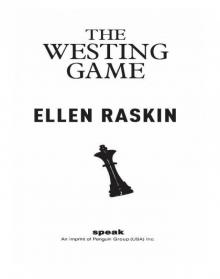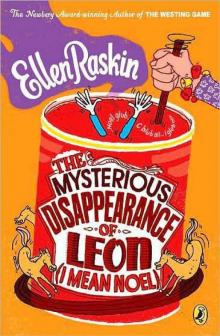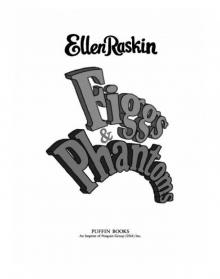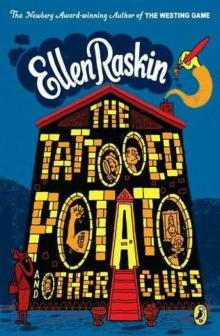- Home
- Ellen Raskin
The Tattooed Potato and Other Clues
The Tattooed Potato and Other Clues Read online
Table of Contents
Title Page
Copyright Page
? - The Mystery in Number 12 Cobble Lane
Chapter 1
Chapter 2
Chapter 3
? ? - The Case of the Horrible Hairdresser
Chapter 1
Chapter 2
Chapter 3
Chapter 4
? ? ? - The Case of the Face on the Five-Dollar Bill
Chapter 1
Chapter 2
Chapter 3
Chapter 4
? ? ? ? - The Case of the Full-Sized Midget
Chapter 1
Chapter 2
Chapter 3
Chapter 4
? ? ? ? ? - The Case of the Disguised Disguise
Chapter 1
Chapter 2
Chapter 3
Chapter 4
Chapter 5
? ? ? ? ? ? - The Case of the Confusing Corpus
Chapter 1
Chapter 2
Chapter 3
The trespasser
Fumbling through her shoulder bag, the trespasser found the notice she had removed from the school bulletin board that morning.
WANTED
Art student to assist well-known portrait painter,
3-6 Mon-Fri, all day Sat. Good pay.
Must be native New Yorker, neat, well-organized.
QUIET! OBSERVANT!
Apply: Garson. 12 Cobble Lane.
Dickory wanted that job. But what if Garson asked to see her portfolio? It was one thing to get accepted into art school with street scenes done with Magic Markers, but ... Dickory bit off the ragged edge of her fingernail. How would she introduce herself if Garson, himself, answered the door? She would say nothing, just hand him the notice. She would be quiet.
Quiet and observant.
NOVELS BY ELLEN RASKIN
The Mysterious Disappearance of Leon (I mean Noel)
Figgs & Phantoms
The Tattooed Potato and other clues
The Westing Game
PUFFIN BOOKS
Published by the Penguin Group
Penguin Young Readers Group, 345 Hudson Street, New York, New York 10014, U.S.A.
Penguin Group (Canada), 90 Eglinton Avenue East, Suite 700, Toronto, Ontario, Canada M4P 2Y3 (a division of Pearson Penguin Canada Inc.)
Penguin Books Ltd, 80 Strand, London WC2R ORL, England
Penguin Ireland, 25 St Stephen’s Green, Dublin 2, Ireland (a division of Penguin Books Ltd)
Penguin Group (Australia), 250 Camberwell Road, Camberwell, Victoria 3124, Australia (a division of Pearson Australia Group Pty Ltd)
Penguin Books India Pvt Ltd, 11 Community Centre, Panchsheel Park, New Delhi - 110 017, India
Penguin Group (NZ), 67 Apollo Drive, Rosedale, North Shore 0632, New Zealand (a division of Pearson New Zealand Ltd)
Penguin Books (South Africa) (Pty) Ltd, 24 Sturdee Avenue, Rosebank, Johannesburg 2196, South Africa
Registered Offices: Penguin Books Ltd, 80 Strand, London WC2R ORL, England
First published in the United States of America by E. P. Dutton & Co. Inc., 1975
Published by Puffin Books, 1989.
This edition published simultaneously by Puffin Books and Dutton Children’s Books, divisions of Penguin Young Readers Group, 2011
Copyright © Ellen Raskin, 1975 All rights reserved
THE LIBRARY OF CONGRESS HAS CATALOGED THE DUTTON EDITION AS FOLLOWS: Raskin, Ellen The tattooed potato and other clues
Summary: Answering an advertisement for an artist’s assistant involves seventeen-year-old Dickory Dock in several mysteries and their ultimate solutions.
eISBN : 978-1-101-48606-1
[1. Mystery and detective stories.] I. Title.
PZ7.R1817Tat [Fic] 74-23764
The publisher does not have any control over and does not assume any responsibility for author or third-party Web sites or their content.
http://us.penguingroup.com
?
The Mystery in Number 12 Cobble Lane
1
A lonely figure stood in Cobble Lane, studying the red-brick house numbered 12. Nervously she clicked a broken fingernail.
No signs of life could be seen behind the muntined (was that the right word?) windows framed by quaint, blue-green shutters. No people, no cars troubled this shy Greenwich Village street.
Only Dickory.
Dickory had never been in Cobble Lane before, although she had lived all of her seventeen years just one mile away—one mile away in a decaying tenement that rumbled with passing trucks and shuddered above the subway’s roar. Here, hidden by the lane’s narrow bend, these small, historic houses stood huddled in silence, untouched by the frantic city that had grown up around them.
Fumbling through her shoulder bag, the trespasser found the notice she had removed from the school bulletin board that morning.
WANTED
Art student to assist well-known portrait painter.
3-6 Mon-Fri, all day Sat. Good pay.
Must be native New Yorker, neat, well-organized.
QUIET! OBSERVANT!
Apply: Garson. 12 Cobble Lane.
Dickory wanted that job. But what if Garson asked to see her portfolio? It was one thing to get accepted into art school with street scenes done with Magic Markers, but.... Dickory bit off the ragged edge of her fingernail. How would she introduce herself if Garson, himself, answered the door? She would say nothing, just hand him the notice. She would be quiet.
Quiet and observant.
Observant Dickory counted the windows: ten in all, three on the second floor, two on the first floor, two in the—someone was watching her from a basement window. No, no one was there. It seemed as if the house itself was watching her as she clutched the cast-iron newel, climbed the one-two-three steps of the brownstone stoop, rang the bell, and waited before the eight-paneled door, painted the same blue-green as the shutters.
At last a bolt lock turned. A man in blue jeans opened the door and took the notice from her outstretched hand.
“Come in. I’m Garson.”
Silent Dickory stepped into the old house to become paint-sorter, brush-cleaner, treasure-keeper, spy, detective, and once again companion to murder.
Double murder.
Dickory followed the artist down the dimly lit hall, through a door at the foot of steep and straight stairs. Unlike the narrow entranceway, the double-storied, oak-paneled room that lay before her was massive. Standing at a carved balustrade, she gaped at the tall, arched windows, the huge, stone fireplace, the antique furniture and Oriental rugs.
“Not that way,” Garson said as she started down the short, curved steps to the magnificent room. “Oh, well, I guess you should have a tour, in case of fire. Or some other emergency.” His tour consisted of a few bored waves of his hand. “Over there, at the far end of the living room, is the garden door. The kitchen is down here under this balcony. Through the kitchen is the furnace room, storeroom, and guest room. A door under the front stoop opens to the street.”
Dickory tried to remember: kitchen under balcony, furnace room, storeroom, guest room, outside door.
“Two men will be taking over these rooms tomorrow; I’m moving to the top two floors. Come, there’s packing to do.” Garson turned and led her into the front bedroom, whose windows looked upon Cobble Lane.
Dickory wondered why Garson had to move upstairs; but she asked nothing.
“Good, you are quiet,” he said. “Quiet people don’t ask questions.”
Dickory had passed her first test.
Trying to be “neat and well-organized,” Dickory began packing the contents of the closets
and drawers into large cartons. A baggy clown suit. A bullfighter’s beaded jacket. A sequined ball gown, very daring.
“Are you a native New Yorker?” Garson asked. He was leaning against the wall, hands halfway into the pockets of his custom-fitted jeans.
“Yes.” Dickory placed a ballerina’s tutu into a carton.
Garson nodded. “Then you won’t be afraid of opening the front door to strangers. That would be one of your duties, answering the door. And the telephone. And cleaning paintbrushes and palettes, etcetera.”
Silently, Dickory folded a black opera cape on top of a sailor’s middy. What did he mean by “etcetera”? And what kind of strangers came to his front door? She reached to the top shelf of the closet for wigs and toupees of all colors and textures, hats and caps of all types and times.
Garson straightened and turned to leave. “By the way, what’s your name?”
“Dickory,” she replied, staring into a drawer stuffed with monocles and medals, eye patches and false teeth.
“Is that your first name or last?”
Dickory sighed. That was not a fair question from a man who called himself Garson, just Garson. “My last name is Dock,” she replied combatively, waiting for the usual guffaw.
Garson didn’t even smile.
Closets and drawers emptied, four large cartons packed, Dickory stood at the foot of the steep hall stairs. Garson had told her to “Give a yell” when she was done, but what should she yell? What do you call someone who has only one name? “Garson” seemed too familiar; “Hey, mister” too crass; “Yoo-hoo” too cute. “Boss”? She didn’t even have the job, yet.
Dickory returned to the bedroom and dragged, shoved, bumped a heavy carton along the floor, over the sill, and through the door. She paused to arch her aching back, waiting for Garson to appear. Surely he must have heard the noise she had made.
Suddenly Dickory became aware of footsteps in the apartment she had just left. Thudding feet clumped up the curved staircase from the living room, coming closer, closer toward the darkening door.
Cringing against the hallway wall, Dickory stared up at a huge, disfigured monster of a man. A jagged scar cut across his smashed face, twisting his mouth into a horrible grin, blinding one eye white and unblinking.
Dickory screamed. The giant lumbered toward her, arms outstretched, fingers jerking wildly. She screamed again.
“I didn’t expect you to take me so literally when I said ‘Give a yell,’ ” Garson said flatly from the top of the stairs. “Oh, I see Isaac is helping out.”
The awful Isaac bent down, flipped the carton onto a massive shoulder, and carried it up to the studio floor. Trembling, Dickory sank down on the bottom step.
“Sorry, I should have told you about Isaac Bickerstaffe,” Garson said, nonchalantly tripping down the stairs. “He lives in the guest room under the front stoop. Isaac is quite harmless and . . . are you all right?”
“I’m fine, just fine,” Dickory replied, pulling herself up by the banister. “After all, I am a native New Yorker.”
“Exactly.”
Dickory followed the portrait painter into the bare bedroom. His tailored jeans were now smeared with paint. He had changed his expensive loafers for dirty sneakers, his starched shirt for a metallic-blue turtleneck jersey. Cold blue, like his eyes.
Garson surveyed the empty room and nodded his approval. “What time is it?”
Dickory looked at the cheaply made, poorly designed wristwatch her brother had given her as a high school graduation present. “It’s a quarter to six, more or less.”
Garson frowned. “I have an important dinner party to go to, so the observancy test will have to wait until tomorrow. Ever hear of the Panzpresser Collection?”
“Yes.” Dickory had never heard of the Panzpresser Collection, but she had something else on her mind. The room was too clean.
“Best private collection of Post-Impressionist paintings in this country. Not that I much care for that school. As far as I’m concerned, art stopped with Fragonard.”
Isaac had returned. Garson pointed to the three remaining cartons, then continued. “Anyhow, Julius Panzpresser is the collector, but his wife is the one with taste. She wants me to paint her portrait.”
Dickory studied the planked floor. Either Garson was joking, which seemed unlikely, or he was a pompous fool, a phony. She kept her head down while Isaac stacked the cartons and carried them out of the room. She could not bear to look at the disfigured creature, and she certainly did not want to be formally introduced.
“Let’s call it a day,” Garson said.
Dickory protested feebly. “I thought I would unpack while you dress for your dinner party. The costumes will get wrinkled if. . . .”
“But I have changed,” Garson replied. “The Panzpressers invited an artist, and they are going to get an artist.”
He was a phony, Dickory decided, as she followed him out the front door.
A taxi was waiting at the curb. “Where do you live?” Garson asked, doubling his long legs into the back seat.
“First Avenue and Fourteenth Street,” Dickory replied, hoping for a ride home. “With my brother and his wife.”
“Have a pleasant walk.” He slammed the door.
Shivering in the early evening chill, Dickory watched the cab drive off, then started on the mile-walk home. She had to walk. She had accidentally packed her purse and jacket in one of the costume cartons.
2
“Who’s Dick Ory?” Professor D’Arches pointed to one of the color compositions propped before the design class.
“The name is Dickory,” She had intentionally signed her name to look like two.
“Do you know what you’ve done here, Dickory?”
“Not really,” she admitted. Using four different Magic Markers, she had composed a square of joined triangles, but it had been difficult working in yellows by candlelight amidst the bickering and squabbling. Her brother and sister-in-law had argued most of the night about who was supposed to have paid the electric bill, and they had argued into the morning and through a breakfast of boiled coffee and untoasted bread over which one of them had spent the money saved to pay the bill. Now, in daylight, Dickory’s color arrangement looked quite different. The yellow triangles were almost indistinguishable from one another.
“A monochromatic design could have included tones and shades, you know,” the professor said. “What do you call this masterpiece, ‘Yellow on Yellow’?”
Dickory didn’t respond. No one responded. D’Arches shook his head in despair. “That was a clever pun, but obviously none of you self-styled artists has ever heard of Malevich’s ‘White on White,’ let alone Futurism or Suprematism.” He sighed. “All right, which genius wants to give his opinion of Dickory’s work?”
A freckled, gangling youth rose and raised his hand. “I think it is very subtle, sir.”
The class giggled at his polite high school manner.
“And which of these disasters is yours?” D’Arches asked.
“The purple one, sir.”
“Well, well, it seems we have a Fauve in our midst. Or is it Naïf?”
“Pardon, sir?”
The professor read the signature on the clumsy arrangement in purple, violet, and lavender. “Sit down, George the Third.”
The blushing young man resumed his seat and smiled at Dickory.
“If this class spent more time on design, and less time on their signatures, I wouldn’t be ruining my digestion on such garbage.” D’Arches pointed to a green composition thick with pigments squeezed from the tube. “Where’s the plagarist who signs himself ‘Vincent’?”
A bearded student defiantly explained that Vincent was his middle name.
“It is also the signature of Vincent Van Gogh,” the professor replied angrily. “Isn’t anyone here original enough to sign his own name? Where’s the joker who thinks he’s Whistler?”
“That signature is not a butterfly,” a chubby young man argued. “I
t’s a silverfish. Harold Silverfish is the name.”
“Get out of here, all of you, this minute. Out!”
Avoiding George III, who wanted to talk to her, Dickory hurried into the library. Professor D’Arches’ short temper had given her an extra half hour before she was due in Cobble Lane, time enough to find out about the Panzpresser Collection and Fragonard. And Garson.
Panzpresser, Julius. 1905—. Art collector and retired clothing manufacturer. Wife’s name: Cookie. Homes in Manhattan and Palm Beach. Art collection, worth $12 million, includes paintings by Degas, Gauguin, Toulouse-Lautrec, Van Gogh, Matisse, Picasso, Sonneborg.
The artists’ names were familiar to her, except the last. She had never heard of Sonneborg, but she had never heard of Fragonard, either.
Fragonard, Jean Honoré. 1732-1806. French painter.
Dickory flipped through the reproductions of Fragonard paintings. The colors were too sweet for her taste, the subject matter too shallow; but she had to admire his drawing skill.
Next, Garson. Dickory had searched through four biographical dictionaries of American artists before she found one short entry.
Garson. 1935- . American portrait painter. Born: Pigslop, Iowa. Father’s name: Gar. Occupation: macaroni designer. Mother’s maiden name: Aurora Borealis. Studied in Paris at L’Ecole de Louvre. Among the celebrities held in posterity under his facile brush are: Juanita Chiquita Dobson, banana heiress. . . .
Dickory slammed the book shut. Just in case there was some truth among those outrageous lies, she looked up two other names. There was no Pigslop in Iowa; there was no L’Ecole de Louvre. She had discovered only one thing about her possible employer: Garson wanted no one to know anything about Garson.

 The Westing Game
The Westing Game The Mysterious Disappearance of Leon (I Mean Noel)
The Mysterious Disappearance of Leon (I Mean Noel) Figgs & Phantoms
Figgs & Phantoms The Tattooed Potato and Other Clues
The Tattooed Potato and Other Clues